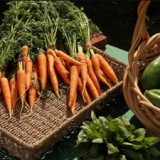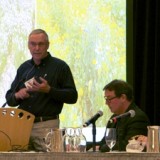Last week Vancouver played host to the annual Seafood Summit, a global conference that brings together fishermen, seafood buyers, chefs, scientists, conservationists, and just about anyone interested in discussing the future of global fisheries. My film “Farmed Salmon Exposed” – which documents the myriad problems with open net pen salmon aquaculture – screened at last year’s conference in Paris; this year I had a chance to hear about potential solutions to the industry’s problems when I attended the panel discussion on land-based closed-containment salmon farming.
The discussion, which featured short presentations from a number of leaders in the emerging industry, highlighted both the encouraging progress of closed-containment salmon aquaculture and the real challenges it faces to becoming a competitive large-scale player in the marketplace. Most importantly, it reinforced a recent shift in the tone of the closed-containment discussion. As panel co-moderator Eric Patel summarized, “The conversation has gone from, ‘Is it feasible?’ to ‘Where is it going to happen, how soon, and how much can it grow?'”
There are a number of concepts and designs for closed-containment salmon farming, but they all share a basic premise of separating farmed fish from the environment by enclosing them in some form of tank system. These methods carry commercial advantages for operators, such as being able to protect their farmed fish from wild parasites, diseases, and other problems like low oxygen events and algae blooms that threaten their stocks; they also allow farmers to better regulate feed, and the fish waste they capture can be converted to fertilizers for sale or used to cultivate other crops as part of a poly-culture system.
Among the Seafood Summit panel were the representatives of three existing and future closed-containment operations. Of particular interest was Per Heggelund, CEO of Washington State-based AquaSeed Corporation. His company has been rearing and selling proprietary breeds of land-based coho for several decades and in 2010 was named official supplier to the Pattison Group’s supermarkets, which include Overwaitea and Save-on-Foods. The decision by the Western Canadian grocery titan to begin phasing out open net pen farmed salmon in favour of closed-containment was an important milestone in the development of the industry.
Also on the panel was Bruce Swift of Swift Aquaculture – a land-based closed-containment farm in Agassiz, BC. Swift is a small family-run operation that raises coho in freshwater tanks, while using the water and waste fertilizers to grow a number of other agricultural products – including crayfish, wasabi, watercress, and garlic – all without pesticides, chemical fertilizers, or antibiotics. They mostly supply local restaurants, including famed Vancouver chef Robert Clark’s C, Nu, and Raincity Grill. Clark, who also presented at the conference on sustainability in the restaurant industry, has been an important customer and supporter of Swift.
The Swift family had a rough go of things initially, unable to escape the stigma of their open net pen counterparts – customers didn’t appreciate the distinction between their farmed product and the rest of the industry. Their experience raises another key challenge to closed-containment salmon aquaculture moving forward: the need to develop a third category of salmon in the marketplace, positioned somewhere between open net pen and wild. Through perseverance and cultivating the right allies, the Swifts have been able to overcome this hurdle. But the industry needs to be able to do the same on a larger scale – which likely requires both consumer education and developing a unique certification to distinguish their product.
Finally, Chief Anne Mack of the Toquaht First Nation, near Uclulet on the west side of Vancouver Island, told the audience of her community’s plans to develop closed-containment farms on their territory (The Namgis First Nation are working on a similar pilot project near Port McNeil on Vancouver Island). Chief Mack discussed how her people are no longer able to live off wild salmon and other now-depleted natural food sources in the way they used to – which explains their interest in closed-containment salmon farming. “This project could help us return to living sustainably off our own territory,” she told the audience. Chief Mack also described the location as ideal in many ways for land-based farming, with good freshwater and brackish groundwater sources. The band is exploring alternate energy systems to help power the farms as well. While they’re still in the planning stage, the Toquaht seem committed and well-positioned to move forward. If they and the Namgis are successful, they could provide a model for other First Nations and similar community-based projects.
Closed-containment salmon aquaculture faces several key challenges, made abundantly clear in the Seafood Summit session. First among these is scale. Can the industry grow enough – and fast enough – to replace, in part or in whole, its much better established open net pen counterpart? It’s clear that demand for the product will long outstrip supply – which is both good and bad. Any developer of a new product would envy the kind of demand closed-containment farmers enjoy from the outset – where the likes of Jimmy Pattison are saying they’ll take as much as you can sell them.
But the industry faces significant challenges to scaling up its operations – including technology, venture capital, and regulatory barriers. Swift Aquaculture may be the ideal model for the future of food production – a small-scale poly-culture system with a low eco-footprint, directly supplying local restaurants – but it’s an entirely different model than the current industrial-scale salmon aquaculture feed lots. And therein may lie the rub. Twenty years from now the only thing that makes sense may be small-scale, low-footprint, local food production – while unsustainable industrial feedlots prove to be a thing of the past. But that may mean years of continued environmental impacts from the open net pen industry before the likes of Marine Harvest collapse or evolve – an unwelcome prospect for those concerned about wild salmon and marine ecosystems today.
On the topic of scale, there is one closed-containment start-up whose system has the potential to compete with open net pen operations. Absent from this panel – but actively involved in the conference in other ways – was BC-based closed-containment pioneer Agrimarine Holdings, which I profiled in a recent video documenting the construction and installation of the world’s first marine closed-containemnt tank. This particular discussion focused on land-based systems, while Agrimarine has developed tanks that sit in near-shore marine waters, anchored to the ocean floor. The company began their research and development well over a decade ago with land-based tanks, but discovered that the energy required to pump salt water uphill was environmentally and cost-prohibitive (both Aquaseed and Swift Aquaculture have chosen to use freshwater for their coho tanks). Already bringing product to market in China, where they installed their first set of tanks last year, and soon to do the same in Canada, Agrimarine is bright spot in the emerging industry. And unlike the much smaller Swift and AquaSeed operations, a group of Agrimarine’s tanks – which range from 50,000-75,000 fish each at this stage – offers a production capacity that approaches large-scale open net pen farms.
On the matter of economic viability for closed-containment salmon, there is much debate. A recent report by Dr. Andrew Wright (available here – second item down) surveyed existing off-the-shelf technology and concluded: “There is no technical or economic barrier to closed containment salmon farm aquaculture for the production of salmon. Moreover, B.C. is advantageously provisioned for catalyzing an industrial change and for retaining the new emergent industry in B.C.”
Predictably, the Department of Fisheries and Oceans – whose support of the Norwegian open net pen industry has constituted a major conflict of interest in the opinion of myself and many others – responded with their own report, downplaying Dr. Wright’s rosy outlook. But this is to be expected from DFO, which continues to ramp up its support of open net pen farms while denying the problems associated with them. While these various small-scale innovators in the closed-containment field may have a ways to go in terms of their unit cost for fish and their overall profitability, continued technical development and economies of scale will only improve their bottom line.
In the q&a session following the presentations, David Lane of BC-based conservation group the T. Buck Suzuki Foundation addressed the other elephant in the room, which is the impact of all salmon aquaculture on the world’s forage fish, needed to feed carnivorous farmed salmon. This subject was discussed in detail at an earlier session that day. Depending on which apples and oranges you’re comparing – and whom you believe, as the numbers are all over the map – it takes anywhere from a couple pounds to 5 or more pounds of wild forage fish, such as anchovies, sardines, and krill, to raise a single pound of farmed salmon. This is a challenge for the industry, whether you’re talking about open net pen or closed-containment farms.
Yet, considerable advances have been made in recent years to improve these feed ratios, and more are in the works. Soy and barley proteins are being used to substitute feed fish; and fish oils essential to boosting Omega-3’s in farmed fish can potentially be derived from algae. By-catch from other fisheries and leftovers from processing fish that would otherwise go to waste are also being used sensibly in farmed salmon feed. Moreover, by enabling less feed waste, closed-containment farms can help in this area as well. But much more needs to be done regarding the feed issue before any farmed salmon product can be touted as truly sustainable.
The most telling commentary at the closed-containment conference session came from Petter Arnesen, Vice-President for Feed and the Environment for Marine Harvest (global) – by far the biggest player in the salmon farming business and owner of roughly half of BC’s farms. Arnesen is a skilled operator who made the trip from Oslo to provide message control for his company – a task he performs far more effectively than the industry’s local PR flaks. His comments here were an interesting departure from what has up until now been the party line for the Norwegian industry with regards to closed-containment – that is, largely brushing it off as a wild-eyed pipe dream. On this occasion, Arnesen was considerably less dismissive: “Closed-containment is not the solution to all the problems of industry…The future of salmon farming is a combination of solutions.” He maintained companies that want to produce the kind of volumes of fish that his does will continue to rely on current methods – but even leaving the door open to some mix of closed-containment was a significant and telling concession from the world’s biggest salmon farmer.
My feeling is that – besides the daunting capital costs and challenges of reproducing the same scale of production via closed-containment – the Norwegian-dominated open net pen industry is reluctant to embrace this new technology because it could undermine the monopoly they currently enjoy in the market. Their vague declarations of “exploring” closed-containment call to mind General Motors’ experience with the EV-1, chronicled in the documentary Who Killed the Electric Car? Like GM didn’t want the electric car to succeed, Norwegian fish farmers really don’t want closed-containment to work – for now, anyway.
Today, these companies enjoy the technical advantages of decades of research and development of their open net pen systems and the ability to externalize many of their costs onto the public and marine environment. Moreover, as ocean tenures are increasingly hard to come by for new farms, the Norwegians face very little prospect of competition from new open net pen players in the future. Were closed-containment to become the norm, opportunities would emerge for farms near urban consumption centres like California, New York and Tokyo – which could open up the market to other players. On the flip-side of this equation, however, is the fact that publicly traded companies such as Marine Harvest and Cermaq/Mainstream don’t just need to sustain themselves – the need growth to satisfy their shareholders. And given these barriers to expansion of the open net pen industry, they may eventually have to turn to closed-containment to provide that new production they crave. It’s a catch-22 you can be sure the industry is grappling with in light of these advances in closed-containment.
The key take-away for me from this Seafood Summit panel discussion and my recent observations on the emerging closed-containment industry is that while it faces an uphill climb and likely many years of continued development to compete head-on with or supplant the open net pen industry, it’s headed in the right direction. The market demand and technical advances for closed-containment are encouraging to say the least. The other piece of the puzzle – much-needed investment capital – would help take things to the next level, though it remains to be seen from where and how much of it will be available in the near future.
Most of the people and companies involved in the closed-containment game came to it because they experienced firsthand the challenges and limitations of open net pen farming. It’s a solution that grew out of a very real problem. Whether or not closed-containment can ultimately work on a large scale (or whether smaller, more local operations are the way of the future anyway), the status quo of open net pen farming is unsustainable in the long-term – politically, environmentally, and economically.
If the Marine Harvests of the world wait too long to evolve with this new technology, they may well find themselves left behind.




